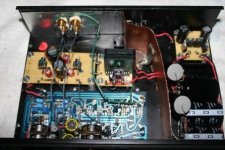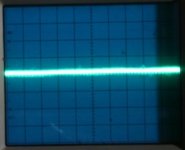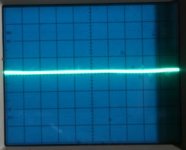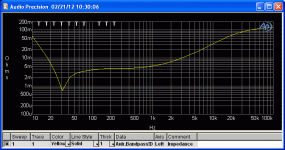I noticed the other Bybee Music Rail thread was shut down, so I'm starting a new one to relate my experience with them. I have just finished rebuilding the low-frequency equalizer unit for my Infinity RSIIb speakers. The EQ is responsible for boosting the bass below 100Hz and contouring the sound up to ~2kHz or so, and the stock unit is less than transparent, shall we say. I have done several stages of upgrades culminating in the current design, in which I have replaced the single-ended MOSFET source follower output stage with a DC-coupled OPA827 opamp based stage, changed out all the old caps and resistors, put in new pots, and redesigned the power supply, moving it off the main board.
The first picture below shows what it looks like now. MUCH more transparent and clean sounding in the present incarnation. Stock all the components were crowded onto the one blue PC board, power supply right next to EQ and output stages, so it really can't help but be better sounding.
In any case, as part of the power supply upgrade I added Bybee Music Rails on the +/- of the 18V split power supply, after the LM7818/7918 regulators- you can see them in the middle of the box on the RatShack perfboard. I took scope readings of the power going into and out of the Music Rails, and they do seem to clean up a lot of the 78xx/79xx noise as evidenced by the narrower trace on the scope (picture 2 is before the MRs, picture 3 is after, 5 mV and 1 mS per division, ). As for the sound, well the unit is extremely clean and direct now, but how much of that is due to the MRs is up for debate - I suppose lower noise is always a good thing, right?
Anyway, there's a little picture for you to chew on. Let the chewing begin!
The first picture below shows what it looks like now. MUCH more transparent and clean sounding in the present incarnation. Stock all the components were crowded onto the one blue PC board, power supply right next to EQ and output stages, so it really can't help but be better sounding.
In any case, as part of the power supply upgrade I added Bybee Music Rails on the +/- of the 18V split power supply, after the LM7818/7918 regulators- you can see them in the middle of the box on the RatShack perfboard. I took scope readings of the power going into and out of the Music Rails, and they do seem to clean up a lot of the 78xx/79xx noise as evidenced by the narrower trace on the scope (picture 2 is before the MRs, picture 3 is after, 5 mV and 1 mS per division, ). As for the sound, well the unit is extremely clean and direct now, but how much of that is due to the MRs is up for debate - I suppose lower noise is always a good thing, right?
Anyway, there's a little picture for you to chew on. Let the chewing begin!
Attachments
Last edited:
By the way, I'd like to commend Bybee Labs for excellent customer service. During the build I ran into some issues with grounding and although it was not their responsibility to teach me the ins and outs of troubleshooting ground noise, one of their engineers (Scott) spent quite a bit of his time, on Saturday and Sunday, helping me think it through and resolve the issue.
So a hearty thank you to Scott and Bybee Labs!
So a hearty thank you to Scott and Bybee Labs!
I must have missed something, but I didn't see any data.
An opinion, yes.
Post revised to change the word data to picture.
I have heavily modified a music hall dac25.2 for a client of mine. Thought it would be a good final touch to install the 2amp music rails
on the +/- 15 volt rails. Well, I read a bunch of the info on their site and started with the positive one. Put the v-out of the music rail on the v+out
of the belleson 78xx regulator, put the v-in of the music rail on the input of the 78xx. My readout on the output of the regulator is now 18v instead of 15v.
Could someone tell me what I'm not doing correctly?
on the +/- 15 volt rails. Well, I read a bunch of the info on their site and started with the positive one. Put the v-out of the music rail on the v+out
of the belleson 78xx regulator, put the v-in of the music rail on the input of the 78xx. My readout on the output of the regulator is now 18v instead of 15v.
Could someone tell me what I'm not doing correctly?
I have heavily modified a music hall dac25.2 for a client of mine. Thought it would be a good final touch to install the 2amp music rails
on the +/- 15 volt rails. Well, I read a bunch of the info on their site and started with the positive one. Put the v-out of the music rail on the v+out
of the belleson 78xx regulator, put the v-in of the music rail on the input of the 78xx. My readout on the output of the regulator is now 18v instead of 15v.
Could someone tell me what I'm not doing correctly?
The Vout of the Belleson goes to the Vin of the Music Rail. The Vout of the Music Rail goes to the circuit you are powering. The Music Rail should drop the voltage by 0.5V if it is working properly. The two grounds can be wired together and then to the ground for the regulator.
By the way, I just put another Music Rail on the DC heater supply for my 2-box tube preamp (PS box connected to preamp box via umbilical). It decreased the ripple substantially, from ~5mV to undetectable on my oscilloscope. Higher frequency noise spikes apparent on the scope were also eliminated. The preamp has a simple rectifier-10KuF cap-LM317 circuit for the DC in a separate power supply box, I put the Rail in after the 317, with a 100uF, 35V cap across the input, just before the tubes in the preamp box. It turns out that my heater voltage had been at 6.78V when it should have been at 6.3V, so the MR voltage drop of 0.5V put me right on the money with the heater voltage - a bit of a happy coincidence!
.
Last edited:
Are they active EMI filters? similar to http://cdn.vicorpower.com/documents/datasheets/Picor/ds_qpi3L.pdf
Similar but they come in both + and - versions. The details of the inner workings haven't been revealed but there is a block diagram in the patent that shows it to be an active filter with an opamp on the output. There is another thread on Diyaudio that discusses the Rails in greater detail, including a link to the patent.
Well, they do something -- in fact, if you carefully examine the impedance from 20Hz to 50Hz it can go down to a micro-Ohm -- this is the positive Music Rail -- since it's just 1/3 octavo from 10Hz the detail isn't quite there, but you get the picture:
Attachments
Their performance on the impulse test is AWFUL --
An externally hosted image should be here but it was not working when we last tested it.
Some usage notes on Bybee Music Rails
Hi
I have applied Bybee's Music-Rails in several cases so far, with very consistent results - significantly reduced noise and no degradation in dynamics.
Here are some examples:
1. DEQX PDC2.6P and HDP-3
This is an active crossover and speaker correction unit with pretty good output stage, but less impressive power supply. I took the power supply out and built a new one from scratch using 100VA trafo, large caps, 317-337 regs, and Music-Rail filters (pos+neg).
Bypass caps are Mundorf M-CAP 10uF Poly's:

2. Naim NAC-32.5 preamp - I used two Bybee Music-Rails for each 24V rail. This is powered by el-cheapo power supply feeding it with raw DC voltage, saving the cost of the external Hi-Cap power supply.
3. Own built power amp, based on Ground-Sound class-AB 300W modules, powered by 800VA trafo, soft recovery diodes and Mundorf monstrous ML-HC caps. I have applied a pair of 15A Bybee Music-Rails to each channel.
4. Aaron No.3 power amp - it is nicely built, but now its much better, thanks to Bybee 15A Music-Rails per each channel. It is very easy to measure the power rail before and after Bybee. The good news, is there was no degradation to dynamics, which came out as a big surprise for me.
The picture below shows only one pair:

In summary - I can highly recommend them to anyone. Some notes from my experience:
1. Do not use them if your source impedance is too high, as the will lose their effect. This makes them more tricky in tube - amps, where the raw voltage is supplied through CRC network.
2. Bypass is very tricky - if you have bypass caps on your rails, you may need to take them out.
3. Do not use series coils, resistors, or long wires after the Bybee's - you may lose their effect.
4. Note they are limited to 30V, if you need higher voltage, you will need to float them with zeners, resistors and more bypass caps (as shown in the above picture) - keep in mind this will require extra space in your box.
Cheers,
Yair
Hi
I have applied Bybee's Music-Rails in several cases so far, with very consistent results - significantly reduced noise and no degradation in dynamics.
Here are some examples:
1. DEQX PDC2.6P and HDP-3
This is an active crossover and speaker correction unit with pretty good output stage, but less impressive power supply. I took the power supply out and built a new one from scratch using 100VA trafo, large caps, 317-337 regs, and Music-Rail filters (pos+neg).
Bypass caps are Mundorf M-CAP 10uF Poly's:

2. Naim NAC-32.5 preamp - I used two Bybee Music-Rails for each 24V rail. This is powered by el-cheapo power supply feeding it with raw DC voltage, saving the cost of the external Hi-Cap power supply.
3. Own built power amp, based on Ground-Sound class-AB 300W modules, powered by 800VA trafo, soft recovery diodes and Mundorf monstrous ML-HC caps. I have applied a pair of 15A Bybee Music-Rails to each channel.
4. Aaron No.3 power amp - it is nicely built, but now its much better, thanks to Bybee 15A Music-Rails per each channel. It is very easy to measure the power rail before and after Bybee. The good news, is there was no degradation to dynamics, which came out as a big surprise for me.
The picture below shows only one pair:

In summary - I can highly recommend them to anyone. Some notes from my experience:
1. Do not use them if your source impedance is too high, as the will lose their effect. This makes them more tricky in tube - amps, where the raw voltage is supplied through CRC network.
2. Bypass is very tricky - if you have bypass caps on your rails, you may need to take them out.
3. Do not use series coils, resistors, or long wires after the Bybee's - you may lose their effect.
4. Note they are limited to 30V, if you need higher voltage, you will need to float them with zeners, resistors and more bypass caps (as shown in the above picture) - keep in mind this will require extra space in your box.
Cheers,
Yair
Hi,
I do not have experience YET with the music rails but since I am quite familiar with the Bybees ( must have a dozen of very effective snake oil cans in my set up ) I want to give it a try.
) I want to give it a try.
Since the Bybee music rails operate completely different to idiotproof Bybees here is my question:
I want to put the Bybee Music Rail in between my Dexa PSU and Dexa Clock
(Neutron Star Reference...I forgive Lars Clausen such a name...ahum)
I read about paying attention to caps before and after the Bybee...this confuses me since well known companies use these with the Dexa in a just inbetween config to mod eg Esoteric and the likes...
I want to hook it in a 15v line DC first leg GND and the following 5 legs 15 v IN
....the next 5 legs 15 v OUT and last leg GND again.
So in between the grey flat cable
Any advise would be welcome....
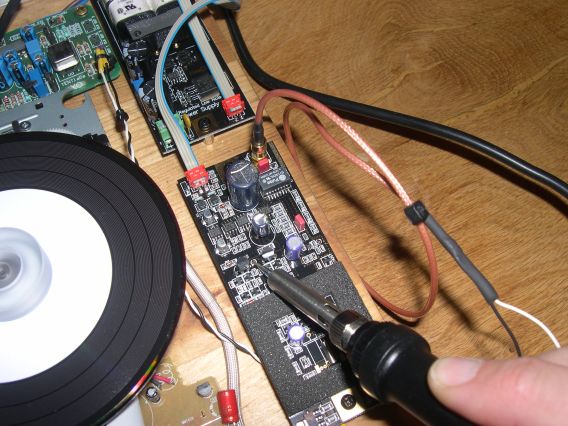
I do not have experience YET with the music rails but since I am quite familiar with the Bybees ( must have a dozen of very effective snake oil cans in my set up
Since the Bybee music rails operate completely different to idiotproof Bybees here is my question:
I want to put the Bybee Music Rail in between my Dexa PSU and Dexa Clock
(Neutron Star Reference...I forgive Lars Clausen such a name...ahum)
I read about paying attention to caps before and after the Bybee...this confuses me since well known companies use these with the Dexa in a just inbetween config to mod eg Esoteric and the likes...
I want to hook it in a 15v line DC first leg GND and the following 5 legs 15 v IN
....the next 5 legs 15 v OUT and last leg GND again.
So in between the grey flat cable
Any advise would be welcome....
Last edited:
Thanks for the info....one keeps wondering why eg ASI -tek the Bybee Music rails implements with the Dexa in a few transports and officially offers the set as a modification done by them....even showing the Esoteric of 15.000 dollar with both in it....
I am not saying that they are right ofcourse
I am not saying that they are right ofcourse
An externally hosted image should be here but it was not working when we last tested it.
- Status
- This old topic is closed. If you want to reopen this topic, contact a moderator using the "Report Post" button.
- Home
- General Interest
- Everything Else
- Bybee Music Rails - My Experience
